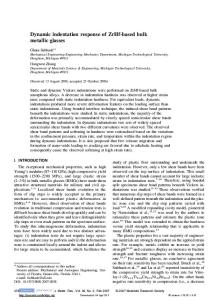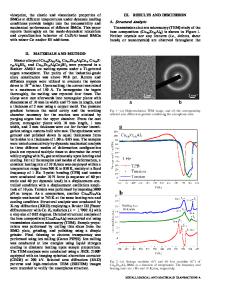The dynamic compressive behavior of beryllium bearing bulk metallic glasses
- PDF / 303,768 Bytes
- 9 Pages / 612 x 792 pts (letter) Page_size
- 89 Downloads / 391 Views
MATERIALS RESEARCH
Welcome
Comments
Help
The dynamic compressive behavior of beryllium bearing bulk metallic glasses H. A. Bruck Idaho National Engineering Labs, Mail Stop 2218, Idaho Falls, Idaho 83415-2218
A. J. Rosakis Department of Aeronautics, California Institute of Technology, Mail Stop 105-50, Pasadena, California 91125
W. L. Johnson Department of Materials Science, California Institute of Technology, Mail Stop 105-50, Pasadena, California 91125 (Received 14 March 1995; accepted 26 October 1995)
In 1993, a new beryllium bearing bulk metallic glass with the nominal composition of Zr41.25 Ti13.75 Cu12.5 Ni10 Be22.5 was discovered at Caltech. This metallic glass can be cast as cylindrical rods as large as 16 mm in diameter, which permitted specimens to be fabricated with geometries suitable for dynamic testing. For the first time, the dynamic compressive yield behavior of a metallic glass was characterized at strain rates of 102 to 104ys by using the split Hopkinson pressure bar. A high-speed infrared thermal detector was also used to determine if adiabatic heating occurred during dynamic deformation of the metallic glass. From these tests it appears that the yield stress of the metallic glass is insensitive to strain rate and no adiabatic heating occurs before yielding.
I. INTRODUCTION
Many components formed from high strength alloys experience dynamic mechanical loading during their fabrication and use, which cause the materials to deform at very high strain rates. In order to understand the limitations of using high strength alloys in these processes, it is necessary to quantify the material’s dynamic constitutive behavior. Insight into this behavior has been customarily obtained using Taylor anvil tests1 or Kolsky bars.2 One class of high strength alloys that can be potentially used in many commercial and industrial applications is known as amorphous metal alloys or metallic glasses. Previously, cooling rate requirements have limited the size of metallic glass specimens available for mechanical testing to cylindrical rods no larger than 2 mm in diameter. Larger specimens are required to obtain reliable data on the mechanical behavior of these alloys. Recently, metallic glasses containing beryllium have been fabricated as ingots up to 16 mm in diameter by directly quenching from the melt.3 Mechanical tests have been conducted on specimens manufactured from these beryllium bearing bulk metallic glasses.4 The quasistatic constitutive behavior of these bulk metallic glasses was characterized in these tests. At that time, all of the constitutive characterization of metallic glasses was performed in quasistatic tests. No data are currently available on the dynamic constitutive behavior of metallic glasses. An attempt was made by Cline and Reaugh5 to determine the dynamic yield J. Mater. Res., Vol. 11, No. 2, Feb 1996
http://journals.cambridge.org
Downloaded: 14 Mar 2015
strength of a palladium alloy metallic glass using the Taylor anvil test; however, they concluded that this was not appropriate. The
Data Loading...











